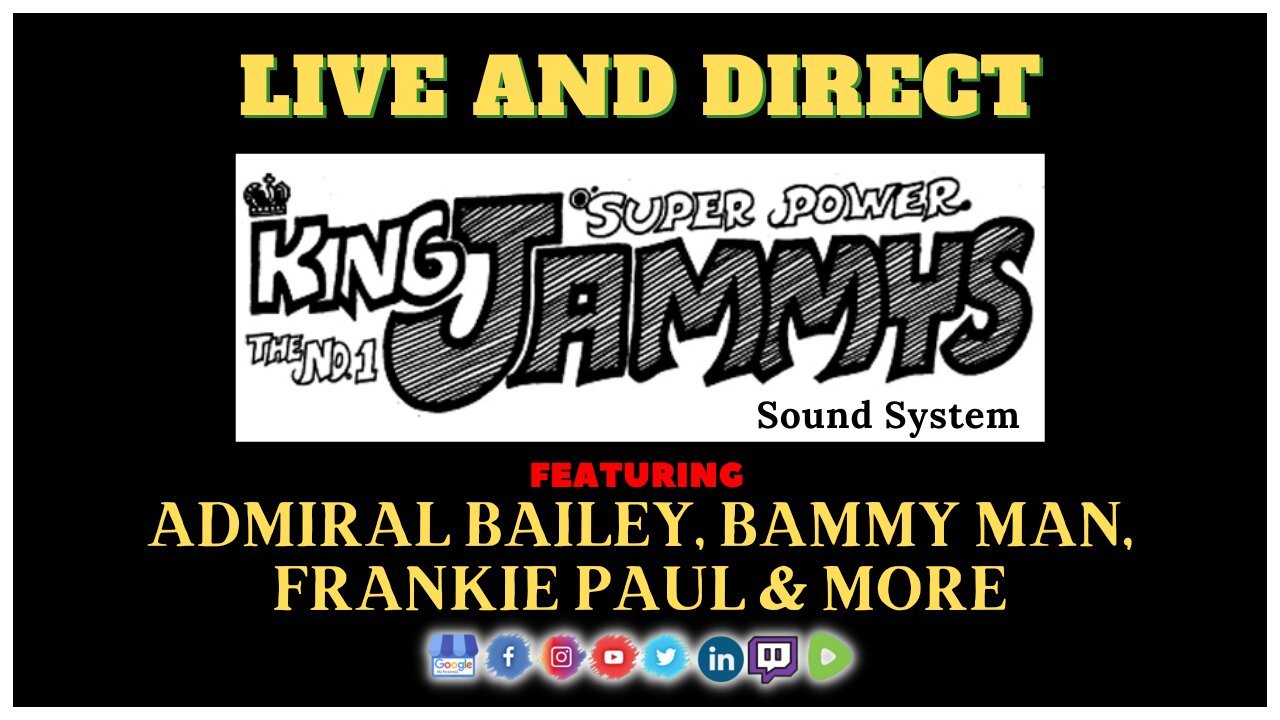Premium Only Content

Official Foundation Reggae Live: King Jammys ft Admiral Bailey, Bammy Man, Frankie Paul & more pt2
Official Foundation Reggae Live: King Jammys ft Admiral Bailey, Bammy Man, Frankie Paul & more pt2
Stay updated & Join Us On Rumble NOW With NO Interrupting Adverts ✅
👇🏾👇🏾👇🏾
https://rumble.com/register/DonSinclair247/
King Jammy, born Lloyd James in Montego Bay, Jamaica, was the undisputed king of computerized digital reggae music during the '80s, as well as a highly reputable producer of dub and roots reggae throughout his lengthy, monumental career. While he established his credentials during the '70s and early '80s (when he was known as Prince Jammy) through seminal production work for Black Uhuru and Sugar Minott as well as dub albums with genre pioneers King Tubby and Scientist, he singlehandedly changed the face of reggae with his all-electronic production of Wayne Smith's 1985 hit "Under Me Sleng Teng," ushering in the digital dancehall era. Following Tubby's untimely death in 1989, Jammy took the crown and continued to be one of reggae's most prolific, innovative producers. He worked with dancehall stars such as Beenie Man and Bounty Killer during the '90s and 2000s, while making off-the-wall dub albums, including collaborations with Mad Professor and Dry & Heavy. He remained active into his seventies, working with roots and dancehall artists like Alborosie and U-Roy on 2016's New Sounds of Freedom, and continuing to push the limits of dub with 2017's Waterhouse Dub.
Lloyd James was born in 1947. Interested in little else but the sound system business from a very early age, James began by building amplifiers and repairing electrical equipment from his mother's house in the Waterhouse area of downtown Kingston and was soon playing live with his own sound system. His prowess earned him a deserved local reputation, and as Prince Jammy, he built equipment for many Waterhouse sounds. He was even acknowledged by the legendary King Tubby, another Waterhouse resident, with whom Jammy often worked.
In the early '70s, Jammy left Jamaica to work in Canada, where his reputation had preceded him, and he was soon working in live stage shows and employed in various studio activities and sound system work. He stayed for a few years but returned to Kingston and set up his first studio (with extremely limited facilities) at his in-laws' home in Waterhouse. At the same time, Tubby's top engineer, Phillip Smart, left for New York and Jammy joined Tubby's team. It was during his time with Tubby that Jammy met the most influential people in reggae; he acknowledges, in particular, the inspiration provided by Bunny Lee and Yabby You. Jammy was continually expanding his own studio and sound system, and in the late '70s, he began to release his own productions, including Black Uhuru's 1977 debut album, coming into contact with many rising dancehall artists such as Half Pint, Junior Reid, and Echo Minott. He also became a prolific producer of dub records and was noted for his clear sound and creative usage of effects. His early albums include 1978's Jammies in Lion Dub Style (on his own Jammys Records) and 1979's Kamikaze Dub (on Trojan). He also recorded several albums with Scientist (beginning with the 1980s Big Showdown, although Scientist has refuted Jammy's contributions to the album) and King Tubby.
Jammy's constant involvement with the grassroots side of the business gave him a keen sense of what was currently happening in reggae, and also allowed him to anticipate new trends. In 1985 he recorded a young singer named Wayne Smith with a tune called "Under Me Sleng Teng," which was to alter irrevocably nature and revolutionize the sound, of reggae music. The basis for "Sleng Teng" was a Casio "music box," and one of the "rock" rhythms from the box was adapted and slowed down to become a "reggae" rhythm. The shock waves were scarcely believable, and before long there were over 200 different versions of the rhythm available, as every producer and artist jumped onto the bandwagon. More than anything else, it opened the music to young independent producers and artists, since expensive studio time and "real" musicians were no longer a prerequisite for recording: digital reggae ruled, and Jammy, the originator, rode the crest of the wave. His records and sound system dominated and controlled reggae music for the remainder of the decade and on into the '90s.
.
❤️💛💚
Uk's Leading Broadcast Station for more Quality Vibes Subscribe to our NEW Platform at Rumble. com for all our latest videos.
(((( █▬█ █ ▀█▀ Subscribe, █▬█ █ ▀█▀ Like & Comment ))))
Website: http://donsinclairreggaevibes.com/
Email: Donsinclairreggaevibes@gmail.com
Shop: https://teespring.com/en-GB/stores/don-sinclair-reggae-vibes-2
Twitter: https://twitter.com/DONSINCLAIR247?lang=en-gb
Facebook: https://www.facebook.com/Donsinclairreggaevibes
Instagram: https://www.instagram.com/donsinclairreggaevibes/
Mixcloud: https://www.mixcloud.com/Donsinclair39/
-
 3:34
3:34
Official Don Sinclair Reggae Vibes
1 year agoOfficial UK Sound System Heritage Mackabee Studio Intl Sound System
98 -
 45:39
45:39
Survive History
13 hours ago $3.76 earnedCould You Survive in the Shield Wall at the Battle of Hastings?
38.7K5 -
 1:50:28
1:50:28
TheDozenPodcast
12 hours agoViolence, Abuse, Jail, Reform: Michael Maisey
82.3K4 -
 23:01
23:01
Mrgunsngear
1 day ago $4.41 earnedWolfpack Armory AW15 MK5 AR-15 Review 🇺🇸
72.5K12 -
 25:59
25:59
TampaAerialMedia
1 day ago $2.26 earnedUpdate ANNA MARIA ISLAND 2025
44.2K4 -
 59:31
59:31
Squaring The Circle, A Randall Carlson Podcast
14 hours ago#039: How Politics & War, Art & Science Shape Our World; A Cultural Commentary From Randall Carlson
34.1K3 -
 13:21
13:21
Misha Petrov
14 hours agoThe CRINGIEST Thing I Have Ever Seen…
27K53 -
 11:45
11:45
BIG NEM
10 hours agoWe Blind Taste Tested the Best Jollof in Toronto 🇳🇬🇬🇭
18.7K1 -
 15:40
15:40
Fit'n Fire
13 hours ago $0.38 earnedArsenal SLR106f & LiteRaider AK Handguard from 1791 Industries
16.3K1 -
 8:34
8:34
Mike Rowe
6 days agoWhat You Didn't Hear At Pete's Confirmation Hearing | The Way I Heard It with Mike Rowe
53.7K23